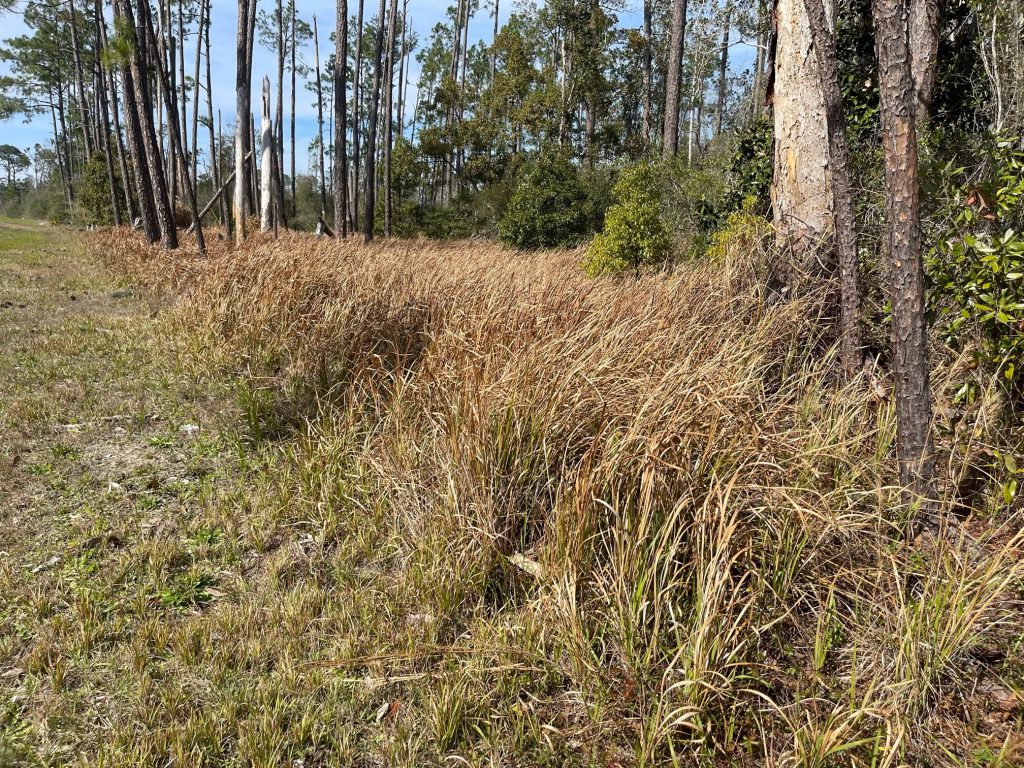Ray Bodrey, Gulf County Extension Director
Cogongrass continues to be a thorn in the side of many landowners and municipal public works departments, as it spreads in areas across the Panhandle, with Gulf County being no exception. Thankfully, there are ways to combat cogongrass, but it seems to be an uphill battle. Identifying and being persistent with treatment are paramount in control.

Figure 1: Cogongrass infestation and uneven mid-rib in leaf blade.
Credit: Ray Bodrey, UF/IFAS Extension Gulf County.
Cogongrass (Imperata cylindrica) is found all over the world. In the U.S, it is primarily found in the southeast. Cogongrass was purposely introduced as a soil stabilizer for pasture lands in Florida during the 1930’s and 1940’s. It wasn’t long before ranchers and agricultural scientists realized that cogongrass was an invasive species. Once established, cogongrass has the ability to overrun pastures and natural areas to the point that it will be the only plant species occupant. It’s a perennial grass with a vast, ever expanding root system. This grass can grow in any soil type and low soil fertility nor drought, are concerns either. Therefore, it thrives no matter how poor the soil environment. Even with multiple days of periods of well below freezing temperatures and a prior application of herbicide, figures 1 & 2 display the resiliency of cogongrass. The major concern is the ability to eliminate native plant habitat.
Cogongrass can be confused with other grasses, like switchgrass. This is especially possible early in the year before the bloom. To identify cogongrass, first investigate the growing pattern. It usually infiltrates an area in patches. As shown in figure 1, the grass blades are flat and have a defining white mid-rib. Blades are finely serrated, yellow to green in color and are uneven in width on each side of the mid-rib. The seed head is fluffy, white and feather shaped. The seed head can alarmingly yield 3,000 seeds per head.

Figure 2: Cogongrass spreading.
Credit: Ray Bodrey, UF/IFAS Extension Gulf County.
The management strategy most successful with eradicating cogongrass consists of multiple types of herbicides sprayed over multiple year applications, with additional spot treatments. Prescribe burning can also be used in concert as an integrated approach.
For control measures, see the tables in the document referenced below. Also, contact your local county extension agent for further details.
Information for this article is from the UF/IFAS EDIS publication: “Cogongrass (Imperata cylindrica) Biology, Ecology, and
Management in Florida Grazing Lands” by B. A. Sellers, J. A. Ferrell, G. E. MacDonald, K. A. Langeland, and S. L. Flory: http://edis.ifas.ufl.edu/pdffiles/WG/WG20200.pdf
UF/IFAS Extension, An Equal Opportunity Institution.
- More Information on Establishing Cool Season Wildlife Food Plots in the Panhandle - November 21, 2024
- Upcoming Event: Panhandle Outdoors Live at St. Joseph Bay on June 21st! - June 3, 2024
- Panhandle Outdoors Live: Woodlot Management - March 11, 2024
